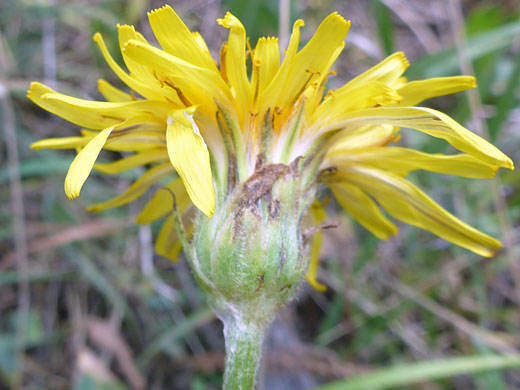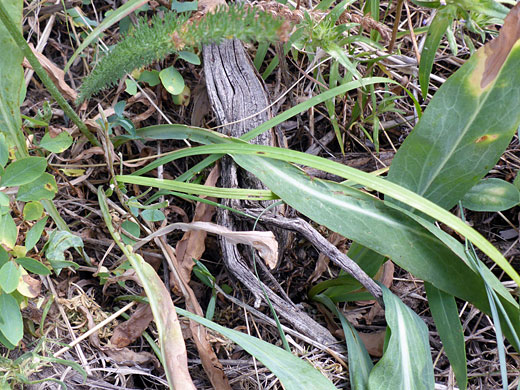
Yellow flowerhead of crepis runcinata, along the Sepulcher Mountain Trail, Yellowstone National Park, Wyoming
Common name:
Meadow hawksbeard
Family:
Scientific name:
Crepis runcinata
Main flower color:
Range:
All the western states (except Oklahoma); less common in the far west
Height:
Up to 2 feet
Habitat:
Alkaline flats, grasslands, bogs, meadows; 1,300 to 9,000 feet
Leaves:
Lanceolate to oblanceolate, up to 12 inches long and 3 inches across, usually with entire margins
Season:
May to September
Crepis runcinata is characterized by nearly or totally leafless stems, and basal leaves generally lacking any lobes - most hawksbeard species have some stem leaves, and lobed basal leaves. Plants produce one, two or three stems, which branch a few times around the midpoint. Leaves are long and thin, quite variable in shape, with edges that may be entire, finely toothed, or (less often) coarsely toothed or lobed. Leaf bases taper very gradually to the stalk. Leaves and stems are usually glabrous, though the top of the stem may have some hairs.
Flowerheads are produced singly or in small, open clusters, of up to 15. At the base of the involucre are between 5 and 12 narrow bractlets (calyculi), while above are between 10 and 16 phyllaries, usually with lightly hairy and/or glandular faces. The yellow florets number between 20 and 50; the corollas have five tiny lobes at the tip, and they mature in stages, so that the inner are shorter than the outer.
There are seven subspecies of crepis runcinata; four (andersonii, barberi, hallii, imbricata) are quite localized, while the others (glauca, hispidulosa, runcinata) more widespread. They differ in leaf shape and width, leaf margin characteristics and phyllary characteristics.
Flowerheads are produced singly or in small, open clusters, of up to 15. At the base of the involucre are between 5 and 12 narrow bractlets (calyculi), while above are between 10 and 16 phyllaries, usually with lightly hairy and/or glandular faces. The yellow florets number between 20 and 50; the corollas have five tiny lobes at the tip, and they mature in stages, so that the inner are shorter than the outer.
There are seven subspecies of crepis runcinata; four (andersonii, barberi, hallii, imbricata) are quite localized, while the others (glauca, hispidulosa, runcinata) more widespread. They differ in leaf shape and width, leaf margin characteristics and phyllary characteristics.
All Contents © Copyright The American Southwest | Comments and Questions | Contribute | Site Map





